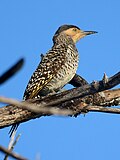| Colaptes | |
|---|---|
 | |
| Gilded flicker (Colaptes chrysoides) | |
| Scientific classification | |
| Kingdom: | Animalia |
| Phylum: | Chordata |
| Class: | Aves |
| Order: | Piciformes |
| Family: | Picidae |
| Tribe: | Picini |
| Genus: | Colaptes Vigors, 1825 |
| Type species | |
| Cuculus auratus [1] Linnaeus, 1758 | |
| Species | |
see text | |
| Synonyms | |
Chrysoptilus | |
Colaptes is a genus of birds in the woodpecker family Picidae. The 14 extant species are found across the Americas.
Contents
Colaptes woodpeckers typically have a brown or green back and wings with black barring, and a beige to yellowish underside, with black spotting or barring. There are usually colorful markings on the head. Many of these birds – particularly the northern species – are more terrestrial than usual among woodpeckers.
Historically, there has been considerable uncertainty in assigning woodpecker species to genera and it is only by comparing DNA sequences that it has become possible to confidently place many of the species.





















